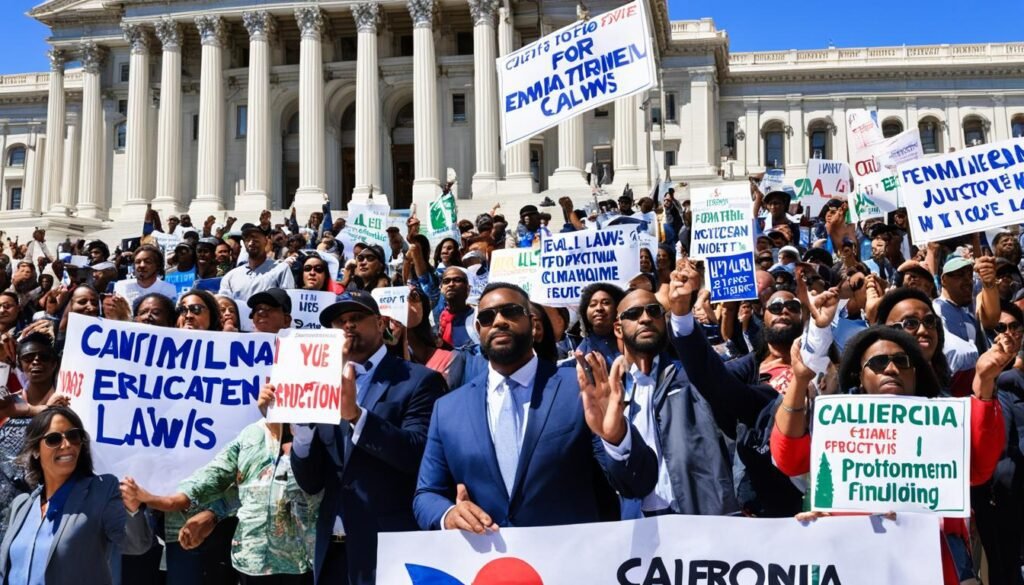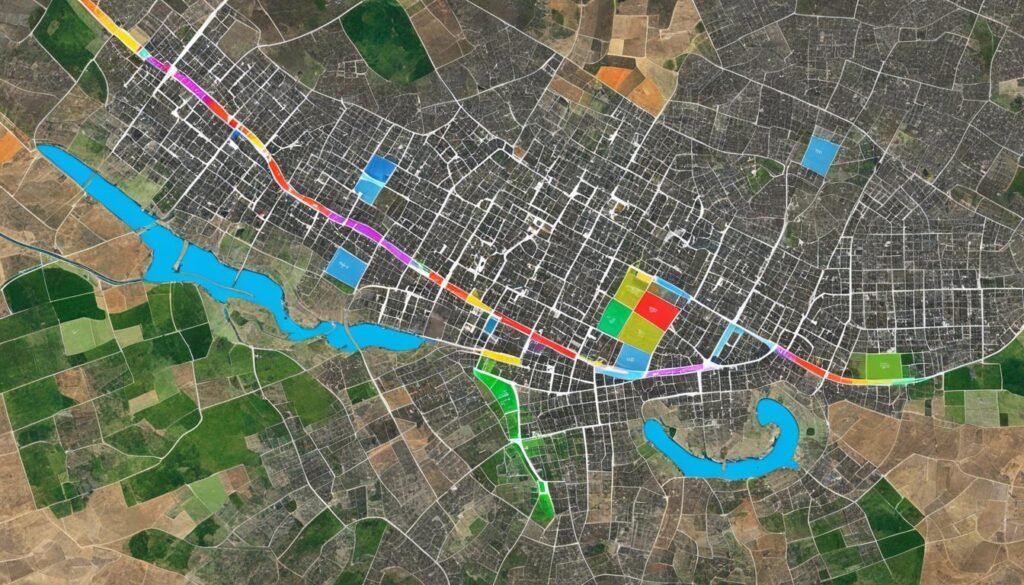As a Californian resident, I’ve always been fascinated by our unique system of direct democracy, which allows us to actively participate in shaping laws and policies through initiatives. If you’ve ever wondered how the initiative process works in California, you’ve come to the right place. In this article, I’ll guide you through the essential steps and provide valuable insights to help you navigate the initiative process in our great state.
Key Takeaways:
- The initiative process in California empowers citizens to propose and enact changes through direct democracy.
- Understanding the steps involved in the initiative process is crucial for anyone seeking to make a difference in California.
- California’s direct democracy system allows citizens to propose and vote on laws and policies through ballot measures.
- Qualifying an initiative for the ballot requires meeting legal requirements and collecting signatures.
- Citizen-led initiatives have a significant impact on California’s political landscape and can influence policy decisions.
Understanding the California Ballot Initiative Process
The California ballot initiative process is a significant mechanism for citizens to propose and enact laws directly. To successfully navigate this process and bring about change through a voter initiative in California, it is crucial to understand the steps and requirements involved.
Drafting the Initiative
The first step in the California ballot initiative process is drafting the initiative itself. This involves formulating the proposed law or constitutional amendment in a clear and concise manner. The initiative must address a single subject and adhere to specific guidelines outlined by the state.
Collecting Signatures
Once the initiative is drafted, proponents must gather a specified number of valid signatures from registered voters in California. The number of required signatures is based on a percentage of the total votes cast for the office of the Governor in the last gubernatorial election. This step often requires extensive grassroots efforts and the support of volunteers, organizations, and campaign strategies to reach the required threshold.
Meeting Legal Requirements
Alongside collecting signatures, proponents must meet various legal requirements to ensure the initiative is valid and can proceed to the ballot. These requirements include verifying the signatures, complying with strict formatting and disclosure rules, and submitting the initiative to the appropriate government authorities within specific timeframes.
Understanding the intricacies of the California ballot initiative process is essential for those interested in creating change through direct democracy. By following the necessary steps of drafting the initiative, collecting signatures, and meeting legal requirements, citizens can play a direct role in shaping California’s laws and policies.

California’s Direct Democracy and Citizen-Led Initiatives
California embraces direct democracy, providing its citizens with the power to propose and vote on laws and policies through ballot measures. As an active participant in the California citizen initiative process, individuals can directly shape the political landscape of the state. Understanding the principles of direct democracy is crucial for those seeking to make a difference through voter-led initiatives in California.
To qualify an initiative in California, potential initiatives must undergo a meticulous process. This involves meeting specific requirements, gathering support from fellow citizens, and navigating legal obligations. By following these steps, individuals can successfully bring their proposed initiatives to the ballot and engage in the democratic decision-making process.
Qualifying an Initiative
Qualifying an initiative in California requires perseverance and strategic planning. Generally, the process involves drafting the proposed measure, collecting signatures from registered voters, and satisfying legal provisions. Often, initiatives are required to gather a specific number of valid signatures within a designated timeframe to advance further in the initiative process.
California law outlines the qualifying criteria for initiatives, which may include factors such as the number of signatures required, geographic distribution requirements, and the verification process. Following these guidelines diligently is essential to ensure the successful qualification of an initiative.
Types of Ballot Measures
California citizens have the opportunity to propose various types of ballot measures. These measures can pertain to a range of topics, including but not limited to policy changes, tax initiatives, and constitutional amendments. By utilizing the initiative process, Californians can advocate for particular causes, address community concerns, and promote change in their state.
Significance and Impact
Ballot measures play a significant role in California’s political landscape. They provide citizens with a way to directly influence state policies and circumvent the traditional legislative process. By participating in direct democracy, individuals can shape the future of California and champion causes that resonate with the general public.

The Power of Citizen Initiatives in California Elections
Citizen initiatives play a pivotal role in shaping the political landscape and influencing policy decisions in California. By allowing citizens to propose and advocate for specific changes, voter-led initiatives empower individuals to have a direct impact on the democratic process in the state.
If you’re interested in proposing an initiative in California, it’s essential to familiarize yourself with the state initiative process and understand the requirements and guidelines you need to follow. This section will provide you with the necessary information to navigate the initiative process successfully.
How to Propose an Initiative in California
Proposing an initiative in California requires careful planning and adherence to specific procedures. To get started, follow these steps:
- Identify an Issue: Determine the issue or policy you want to address through an initiative. It should be a matter of public concern that you believe needs attention.
- Draft the Initiative: Prepare a clear and concise text for your proposed initiative. The language must be accurate, comprehensive, and compliant with the relevant legal requirements.
- Seek Legal Review: Consult with legal professionals or organizations experienced in the initiative process to ensure compliance and avoid any potential legal challenges.
- Collect Signatures: Gather the necessary number of valid signatures from registered voters in California. The number required may vary depending on the type of initiative and the specific requirements set by the state.
- Submit the Initiative: File the completed initiative, along with the collected signatures and other required documentation, to the appropriate authority responsible for initiatives in California.
By following these steps, you can maximize your chances of successfully proposing an initiative in California.
Impact on California Elections
The initiatives proposed by citizens significantly impact the electoral landscape in California. Successful initiatives can introduce new laws and policies, while those that gain significant attention can influence voter sentiment and shape political debates throughout the state.
Furthermore, the process of discussing, campaigning for, and voting on initiatives encourages civic engagement and voter participation. It empowers individuals to voice their opinions and actively contribute to the democratic process beyond traditional voting for candidates.

The image above illustrates the power of voter initiatives in California, showcasing the direct impact citizens have on shaping the state’s laws and policies.
Challenges and Controversies Surrounding California Initiatives
The initiative process in California is an integral part of the state’s democratic system. However, it is not without its fair share of challenges and controversies. Critics often raise concerns about the state’s election system, questioning its effectiveness in managing the initiative process.
One of the primary challenges with California initiatives is the influence of money in initiative campaigns. Critics argue that well-funded interest groups and wealthy individuals can have a disproportionate impact on the outcome of initiatives, potentially undermining the democratic principles of citizen-led action.
In addition, legal disputes over the validity of initiatives can create controversies. Courts sometimes intervene to determine whether an initiative meets the legal requirements for inclusion on the ballot. This can lead to lengthy legal battles and uncertainty surrounding the fate of proposed initiatives.
Despite these challenges, California’s initiative system remains a robust avenue for citizen participation in governance. By understanding and addressing these controversies, we can continue to uphold the democratic values that underpin the initiative process in California.
FAQ
What is the initiative process in California?
The initiative process in California allows citizens to propose and vote on laws and policies through ballot measures, resulting in direct democracy.
What are the steps of the initiative process in California?
The steps of the initiative process in California include drafting the initiative, collecting signatures, and meeting legal requirements to qualify for the ballot.
How does the California ballot initiative process work?
The California ballot initiative process requires citizens to gather a certain number of signatures from registered voters to qualify their proposed initiative for the ballot.
What is direct democracy in California?
Direct democracy in California refers to the power of citizens to propose and enact laws through ballot measures, bypassing the traditional legislative process.
How do citizens qualify an initiative in California?
To qualify an initiative in California, citizens must meet legal requirements, such as collecting a specific number of valid signatures within a certain time frame.
What are ballot measures in California?
Ballot measures in California are proposed laws or changes to the state constitution that are put directly to the voters for approval or rejection.
How can I propose an initiative in California?
To propose an initiative in California, you must draft the initiative, submit it to the attorney general and state officials for review, and then collect the required number of signatures from registered voters.
What are the requirements for a California citizen initiative?
California citizen initiatives must meet certain requirements, such as addressing only one subject and not conflicting with existing laws or the state constitution.
How do voter initiatives impact California elections?
Voter initiatives in California shape the political landscape, as they allow citizens to directly participate in decision-making and influence policy outcomes through the ballot.
What challenges and controversies surround California initiatives?
California initiatives face challenges and controversies, including criticism of the state’s election system, concerns about the influence of money in initiative campaigns, and legal disputes over initiative validity.







